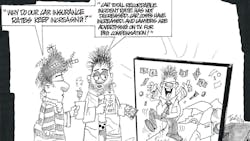Improving safety performance: compliance vs. competence, part 1
In this multi-part series, Michael Taube, a principal consultant at S&D Consulting, offers insights on stagnation in process safety performance, and where the process industries could and should make practical improvements to address opportunities.
Michael, what’s happened?
Michael: Over the past 40 years, we witnessed an extraordinary promulgation of safety regulations and associated “safety management systems,” which resulted in the improvement of personal and process safety performance (SP). Over the last 10-20 years, however, SP plateaued at a total recordable incident rate (TRIR) of 10-7, and significant events continue to occur and at sites with “excellent” safety records.
There’s been much published research and numerous books by researchers such as Sidney Dekker, Todd Conklin and Nancy Leveson, to name a few, which advocate an alternative approach or “new view” for improving SP. They recognize and explore such aspects as human performance, mental models, human error, organizational accidents, safety engineering and high-reliability organization (HRO) practices. The “old view” is largely based on compliance, which consists of bureaucratic paperwork and enforcement, management systems and error or deviance tracking. The new view is based on capacity or competence embedded in and reflected by the people at the sharp end—who are involved in the most difficult or dangerous aspects of work—particularly through identifying and addressing safety issues on their own initiative.
While not advocating complete abandonment of the safety activities that got the process industries (PI) to where they are today, the new view highlights shortcomings and changes in perspective, attitude and practices required to have measurable improvements in SP beyond the 10-7 rate. Nevertheless, the PIs have yet to embrace, much less pursue, this new perspective and seemingly prefer to do more of the same, all while expecting the outcomes to change.
This series intends to spur introspection regarding the underlying assumptions about how SP is achieved and generate brutally honest, even heated, debate about the organizational and cultural changes—mindset, attitudes, policies and practices, and leadership philosophies throughout all levels of the PIs—which the new view proposes are required to achieve the ever-elusive goal of zero incidents. In addition to SP improvements, if/when the new view is pursued in earnest, this column expects there will be other positive business outcomes, such as improved uptime, reduced break-in work, improved schedule and cost performance in turnarounds, and fewer unplanned outages, all of which improve profit.
Greg: What is the old view?
Michael: The core principle of the old view is that people are the problem, thus human error must be eliminated. We see this reflected in how SP is monitored and tracked. It consists of personal protective equipment (PPE) violations, deviance/error tracking, etc.
Greg: What are the shortcomings and failures of the old view, and where do the process industries get it wrong?
Michael: There are several areas where the PIs get it wrong with safety. The first, I hear quite often, is when managers make peer group comparisons—looking inward rather than at other high-consequence industries. I refer to this practice as “navel gazing.” The fallacy of this perspective is that claiming you are the best-in-class of a poor-performing class is not really saying much.
Another mistake PIs make is treating emergent properties, such as safety, profit, operational excellence, etc., as things that can be “managed.” Emergent properties are the result or output of the PI’s systems (procedures, policies, practices) and their inputs (staffing, training, supervision, budgets, etc). These systems can be (re)designed, optimized, etc, and their inputs can be managed, but the outputs can’t be managed. If one doesn’t like the results one gets, one has to examine the inputs and the systems for areas/items to alter or adjust to get different results.
Process industry management also mistakenly equates activity with progress, and the use of lagging indicators (TRIR, safety observations, etc) instead of leading ones on achieving safety. In summary, the PIs address SP by attacking symptoms rather than systemic causes. This approach leads to several myths and illusions regarding process safety management (PSM).
Greg: What are some of these myths and illusions?
Michael: The seven myths are: safety is achieved by more procedures, more safety observations, more field staff safety training, more KPIs, dashboards and reports, as well as more management engagement and financial incentives, enforcement, and process safety organization and bureaucracy. The key feature is doing more of the same, while expecting different outcomes. The record on SP so far shows we’ve reached a point of diminishing returns, so doing more won’t make us any safer.
The three illusions are: past/present success is evidence of best practices, lack of events is evidence that everything is in/under control, and past/present success is a guarantee of future success. Again, the record tells a very different story.
Greg: What is the new view?
Michael: The new view explicitly recognizes that human error is normal and can’t be eliminated. The systems in which humans perform their work must be resilient enough to prevent errors from resulting in undesired outcomes. An integral part of the new view is competence by the boots on the ground instead of just compliance. The people at the sharp end—the ones who do the work—are part of the solution.
To put a finer point to this, compliance has you do only what’s required by regulation (according to management dictates), while competence results in workers at the sharp end finding and fixing problems as they arise before something undesired happens. In compliance, regulations define the maximum requirement, whereas for competence regulations describe minimum requirements. Compliance creates a bureaucratic exercise up the chain of command, whereas competence creates a moral responsibility down the chain of command.
Compliance results in updating KPIs, dashboards, reports after some adverse event, whereas competence debriefs successfully completed tasks to identify holes, errors and omissions in work procedures. In compliance, management is incentivized for activity. In competence, workers “own” safety rather than having it forced on them. In compliance, workers are subjected to mandatory safety training, which relieves a company of liability. In competence, workers identify and correct latent hazards and deficiencies, making conditions and practices safer.
Greg: How is competence attained?
Michael: Competence requires that process industry facilities and companies become “learning organizations” (see Peter Senge’s The Fifth Discipline). PI management must understand the difference between work as imagined (how they think it’s done) versus work as it’s really done. Staff (and supervisor) training must use real-life (but simulated) training scenarios similar to other high-consequence industries, such as commercial aviation and the U.S. Navy Submarine Force.
Greg: How does the new view affect staff recruitment, training and selection?
Michael: This is where the rubber really meets the road. Many companies take the position of hiring “only the best.” This approach severely limits their choices since the “best” represents a very small fraction of the total pool of potential candidates. As Adm. Hyman G. Rickover, the “Father of the Nuclear Navy,” once said in a television interview, “The best already have good jobs. I hire men with potential and then train them.” Robert Kiyosaki, author of the Rich Dad Poor Dad series, also highlights a dichotomy found in business where “A” students work for “B” students, who work for “C” students.
The process industries must take a similar approach. It must adjust recruiting and hiring practices to recognize that academic performance alone isn’t an accurate reflection of a person’s capability. Furthermore, PI must take Adm. Rickover’s approach to train people on the details of the unit operations and the hazards of their specific plant (not just safety policies and procedures). To be clear, this isn’t about lowering standards to get people in, rather it’s about meeting higher standards and requirements to stay with the organization. This approach turns the typical recruiting strategy on its head—instead of looking for the “perfect fit” candidate that’s much like hunting for “pink unicorns”—it requires a retraining or adjustment of expectations placed on recent graduates and experienced people, as well as onboarding and qualification programs, policies and practices.
Greg: What must change to transition to competence?
Michael: First, the process industries must recognize that human error is normal and can’t be eliminated. This represents an almost seismic shift in thinking and policies around safety. Second, it must eliminate flat organizations, which created top-heavy organizations with too few boots on the ground and siloed groups or little fiefdoms. Next, it must rebuild the organizational base/foundation (supervisors and staff) by reinvesting in and rebuilding staff training programs. These include technical fundamentals and foundations specific to the operation and hazards of the processes they work with. Also, incident/accident investigations must become organizational learning opportunities rather than “firing squads.” Management must be engaged with the workforce at a personal level—not superficially—to understand how work really gets done. Metrics, especially those tied to financial incentives, must reflect progress and performance, not activity, such as latent hazards that can be identified and corrected versus jut making safety observations. Successes, such as maintenance work, turnarounds and routine work, must be debriefed, so mistakes are captured and holes and deficiencies are identified for correction. This will make the system more resilient and less susceptible to failure due to mistakes.
Greg: What’s keeping the process industries from pursuing competence?
Michael: The biggest impediments to progress are fear of failure and being “outside the norm,” and fear of deviating from standard practices. Another issue is a severe lack of leadership. The process industries are burdened with a deplorable excess of management and too few true leaders. An operative expression for this is “one manages things but leads people.” There is also the perception that we’re “good enough” or what we produce isn’t that dangerous, such as asphalt, sugar, grain or ethanol, so our facility or company doesn’t need to be a “regulated site.” For the more-bad-advice accounting-trained managers, it’s very hard to capture a return on investment (ROI) for competency, and know why and how to spend the effort and money.
Lastly, something I realized very early in my career is that, as an industry, we spend lots of time, effort and money to ensure nothing bad happens. But this runs completely counter to how the human mind works. It’s a goal-seeking machine. The trick is to give it the right goal to pursue.
Top 10 issues that don’t reduce safety incidents:
10. Management makes all the big decisions.
9. Everyone is busy, so management thinks everything is good.
8. Improvements require sufficient ROI.
7. Management likes to hear about successes, not failures.
6. You’re stuck in standard practices.
5. Management gets rid of people who make mistakes.
4. The focus is on getting more bang for the buck.
3. Periodic update of dynamic simulation and training with digital twins are suspended.
2. Attendance at safety conferences stops because it takes people away from their jobs.
1. You wait until there’s an incident to figure out what to change.
About the Author
Greg McMillan
Columnist
Greg K. McMillan captures the wisdom of talented leaders in process control and adds his perspective based on more than 50 years of experience, cartoons by Ted Williams and Top 10 lists.

Leaders relevant to this article:

